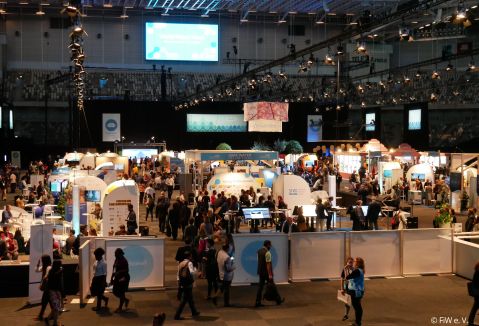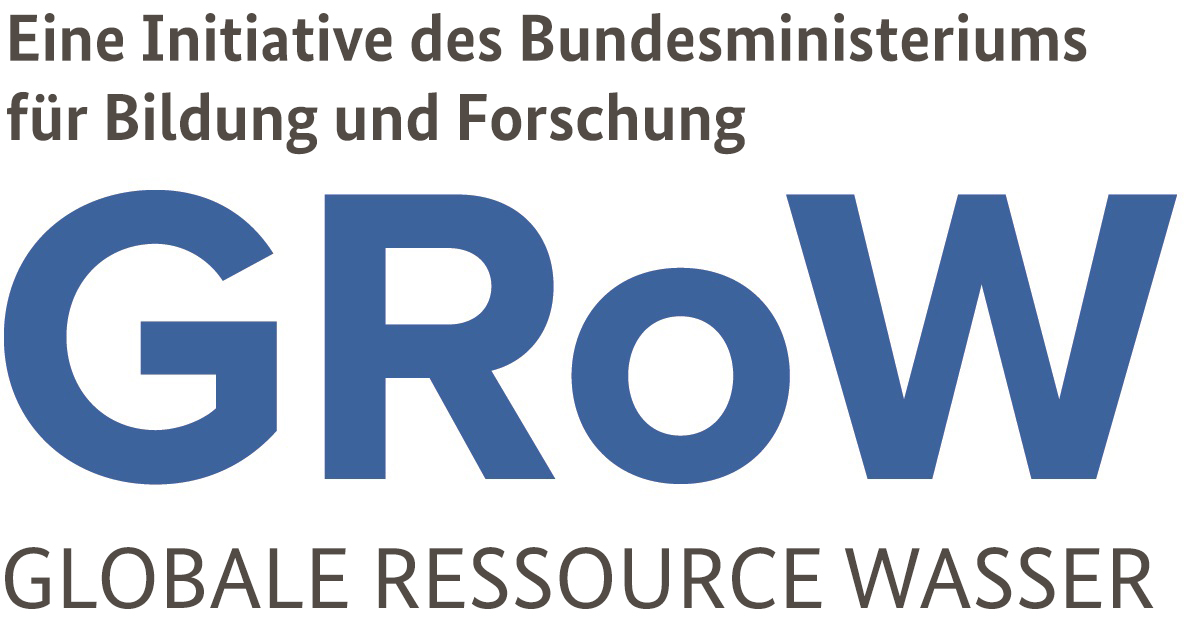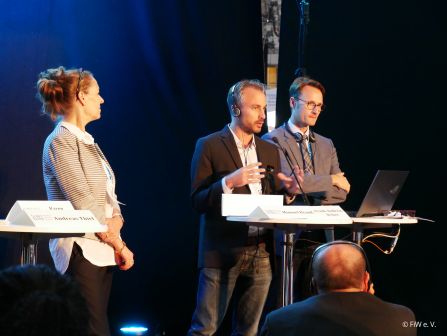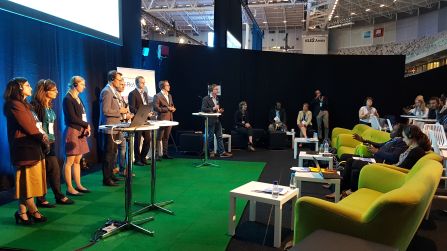
Water is a scarce resource and thus plays a critical role in reaching the United Nation’s Sustainable Development Goals (SDGs). Without water, life cannot be sustained and without using water in agricultural production, food cannot be produced. However, many people still do not have access to clean and safe drinking water and sanitation. Accordingly, the slogan at this year’s World Water Week in Stockholm was: “Leaving no one behind - water and sanitation for everyone”. From 25 to 30 August 2019, scientists, water managers and policy-makers discussed strategies that may contribute to solve the global challenges of unequal distribution of water, lack of drinking water, and insufficient sanitation. Two events highlighted different approaches developed within GRoW to help achieve the SDGs – based on the work of the GRoW cross-cutting topics “SDGs - Hitting the targets” and “Water footprint”.
SDG trade-offs and synergies
GRoW researchers and other experts presented and discussed methods to analyse and address interlinkages across SDGs, particularly between SDG6 and other water-related goals. Keynote speaker Stefan Uhlenbrook (UNESCO WWAP) highlighted the importance of assessing interlinkages of SDG 6 with other SDGs to inform policy-making, as water is key to advancing human rights, reducing poverty and inequality, and enabling peace, justice and sustainability. Science has an important role to play, e.g. by helping to better understand which interlinkages actually exist and which factors affect coordination and cooperation across different sectors. Also, science can provide sound assessment of data and methods for implementation and measuring progress on SDG6, as well as predictions on future changes.
GRoW experts Frank-Andreas Weber (FiW e.V. Aachen) and Manuel Krauß (Universität Stuttgart) presented a new assessment procedure with which decision makers can evaluate the effects of key projects and policy strategies on achieving UN-SDG targets, including indirect trade-offs and synergies. The objective is to demonstrate the importance of SDG 6 in achieving other SDGs using regional expertise and best practices from work generated within GRoW projects. This assessment procedure aims at supporting decision-making to harness synergies and mitigate potentially conflicting approaches. Groundwater specialist Karen Villholth (IWMI) further underlined which trade-offs specifically exist with respect to groundwater – such as climate change impacts on groundwater, or implications of groundwater management on agriculture - and how careful consideration must be given to these in order to avoid unintended negative outcomes.
Andreas Thiel (Universität Kassel) presented potentials and pitfalls of coordination for addressing SDG interlinkages based on the Diagnostic Approach developed within the STEER project as an example on how to mitigate potentially conflicting approaches in water management. Susanne Dorasil (BMZ) completed the picture by introducing the new strategy of German development cooperation for interlinkages between water, sustainable economic development, job creation and vocational training. This presentation can be seen as an example of how policy-makers intervene to harness synergies and avoid potentially conflicting approaches in country strategies and programme proposals for official development cooperation.
More information on the event can be found here.
Water Footprint
GRoW experts focussed on the possibility of improving and expanding the water footprint as an instrument for decision-making, aiming to explore the potential of applying current water footprint approaches that go beyond expression of litres of water consumed. Keynote speaker Markus Berger (TU Berlin) introduced the water footprint concept and explained its potential to support achieving various SDGs – not only with respect to water resources (SDG 6), but also by analysing impacts on humans (SDG 2) and on ecosystems (SDGs 14 & 15). The water footprint concept can also be used to raise awareness on more responsible consumption and production (SDG 12), e.g. by integrating it in labels or tools supporting stakeholders in reducing their water footprints. The water footprint has therefore much potential to guide various stakeholders, e.g. sectoral policies and planning, consumers and producers, in their decision-making. Despite scientific advancements of the water footprint concept, some methodological and practical challenges remain. Many studies still focus on volumes and neglect local impacts of water use, as well as green water and water quality aspects.
Some of these challenges are being addressed in GRoW projects. Among them, the project InoCottonGROW developed the water footprint concept into a governance tool to help local decision-makers manage scarce water resources. Frank-Andreas Weber (FiW e.V. Aachen) presented several options of interventions considered within this project to reduce the water footprint of cotton-textile production in Pakistan. Silvia Forin (TU Berlin) presented the method developed by the WELLE project to assess the organizational water scarcity footprint. Aurélie Wojciechowski (Evonik Nutrition & Care GmbH) showed insights gained by using this method on the water scarcity footprint of the production of amino acids. Evonik aims at developing a water stewardship approach for their Biolys ® production and wants to integrate water scarcity indicators in their future purchase decisions. Finally, on behalf of the ViWA project, Anna Schlattmann (Leibniz Universität Hannover) showed how linking water footprints with agro-hydrological model data can help in defining sustainable management options and sustainable import regions, particularly in agriculture.
Facilitator Falk Schmidt (IASS Potsdam) then opened the discussion with the audience by inviting other experts to provide their views on how to transfer the water footprint concept into practice. Rick Hogeboom (Water Footprint Network) emphasized that the water footprint has often proven useful in decision-making, although the challenge remains to further simplifying it to mainstream its use. Knowing the stewardship perspective on the ground, Robin Farrington (GIZ) acknowledged the potential of the water footprint for risk management on the local level.
Research on the water footprint concept does not seem only driven by funding – many of the stakeholders involved in this event agreed on that GRoW projects developed approaches that were directly relevant to their decision-making processes, either to reduce the water footprint at company level in their specific supply chains or to take more sustainable management and policy decisions on a regional level.
More information on the event can be found here.
Downloads synergies and trade-offs
Wolf: SDG trade-offs and synergies
Uhlenbrook: The Importance of Assessing SDG 6 Interlinkages to Inform Policy Making
Weber; Krauß: New approaches towards assessing trade offs and synergies between SDG 6 and other SDGs
Villholth: Groundwater and SDGs: discerning interlinkages for sustainable outcomes
Downloads Water footprint
Wolf: Supporting SDG 6 by advancing the water footprint tool
Berger: Current WF approaches and their potential to support achieving the SDGs
Weber: Reducing the water footprint of the cotton textile industry in Pakistan (InoCottonGROW)
Forin; Wojciechowski: Water Footprint of Organizations Local Actions in Global Supply Chains (WELLE)


